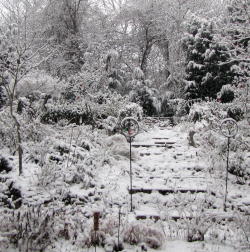
The title refers not to garish ghouls or nightmarish ne’re do wells but rather the contents of the part of the Fairegarden referred to as the black garden. It has been in existence three years now and has been filled, some might say overfilled with plants that either have dark leaves, flowers or are so named. We begin with the daylily denizens, showcasing the newest arrival, just purchased last weekend at nearby Champion Daylilies, Hemerocallis ‘Buddy’s Black Jack’. It was love at first sight of this bicolor so Buddy was added to the collection which can be seen in total on the sidebar page listing, Plants We Grow-Daylilies, or click here. The other dark flowered daylilies in this bed are Bela Lugosi, Black Prince, Night Beacon, Chicago Regal, Soot Storm and the tall double H. fulva flore pleno/kwanso, must count the petals, which keeps returning even though it has been dug out many times.


Lilies are also well represented in the area, shown are Asiatic Liliums ‘Landini’ and L. ‘Cappucino’, gifts from daughters Semi and Chickenpoet respectively. Others of this family that are grown together in the den of darkness, well it is quite sunny, not dark but think metaphorically please, species Black Beauty, Asiatic Monte Negro, unknown red Asiatic from a mixture, Chinese Trumpet ‘African Queen’ and ‘Lady Alice’, ‘Tiger Babies’ and Orienpet ‘Robert Swanson’. Also seedlings of Chinese Trumpet ‘Black Dragon’ still very tiny, thanks MMD! There is also a page Plants We Grow-Lilies on the sidebar, or click here.

Trees and shrubs are limited due to space constraints but include the deciduous azaleas Mt. Saint Helen’s, shown above and the never blooming, yet, King Red. The King was planted just before the late killing freeze of 2007 and is slowly regaining stature and strength. Next year might be the year of flowering, it is hoped. There is, again a page on the sidebar called Plants We Grow-deciduous Azaleas, or click here.


The darkest leaves are represented by Physocarpus opulifolius ‘Summer Wine’ and the purple leaf peach which was the starter planting for the black garden, a passalong rooted cutting from good neighbor Mickey, he even planted it for me. Crocosmia ‘Lucifer’ has spread throughout, the tall red blooms are welcome and join the rest of the Crocosmia collection. (No page for them just yet, hopefully this will be the year they are codified and published, although there is a post here-Winter Plant Portrait-Crocosmias.) Before it was the black garden, it was to be a patch of lavender, the only monoculture here, if the groundcover of Ajuga repens isn’t counted that is. The lavender kept dying, being replaced with cuttings of nearby plants, in fact the whole thing was cutting grown, but our climate and soil conditions ruled out the vision of a lavender field ala Provence. The idea of a themed garden of black with color punches of red, orange and purple to brighten the scene was hatched.

Finding suitable occupants is quite enjoyable. The garden is filled with black or dark flowers and leaves and gothic type names, such as Aquilegia ‘Black Barlow’. Perhaps seeds of these could be scattered right now. Other trees/shrubs living in the home of dark/black already include two seedling butterfly bushes with purple/blue flowers trained as standards, and a red leaf birch tree, Betula ‘Crimson Frost’ that has not grown very rapidly but does show improvement with each passing year. Reading the blurb on the Mobot site, it becomes clear why this tree is not doing well here: prefers evenly moist soil, snow cover on the root zone in winter and summers not above 75F. We have none of those, it is a wonder that it is alive at all. There is a row of Viburnums seperating the black from the white/yellow bed just to the west that includes V. ‘Blue Muffin’, ‘Winterthur’, ‘Brandywine’, three ‘Cardinal Candy’, opulus ‘Xanthocarpum’ and plicatum. These are all still small and the planned Viburnum hedge might have to be modified as they grow larger.

One rose resides, R. ‘Fairy Queen’ and one type of Astilbe, A. arendsii ‘Fanal’. These, among others, line the edge to cover dying tulip foliage.


Tulips mark the beginning of flowers in the black garden. While most tulips are not reliable at returning here, the two above, Walmart Orange and Queen Of The Night have so far brightened the spot each April. Black Mondo, Ophiopogon planiscapus ‘Nigrescens’ marks the Queen tulip placement and Japanese blood grass the orange. At one time Ballerina was growing here but has not returned. It might be replanted this fall after seeing them at Great Dixter. At risk of sounding like a broken record, there is a page on the sidebar called Plants We Grow-Spring Bulbs, or click here.

Monarda didyma ‘Raspberry Wine’ stands tall next to the trumpet lilies, borrowing from their stakes if needed to remain upright.

Sedum ‘Purple Emperor’ is the go to edging, enjoying the partial shade provided by the peach tree that has been recently limbed up to provide air and light underneath. Other perennials include Penstemon digitalis ‘Husker Red’, Ageratina altissima ‘Chocolate’, Actaea racemosa ‘Atropurpurea’, Panicum virgatum ‘Heavy Metal’, Sedum ‘Black Jack’ , Origanum ‘Rosenkuppel’, Euphoriba dulcis ‘Chameleon’, Bergenia ssp., pink Calla lily (don’t ask) and various irises including Superstition. Tall Vernonia gigantea seedlings have been added for some late season purple towers. Self seeding to the point of weediness, purple leaf and blooming Perilla frutescens is allowed to spread in there. Rudbeckia hirta ‘Cherry Brandy’ is growing nicely. It remains to be seen if we can keep them going through judicious seed spreading before they make the permanent list. Said list may be incomplete for every trip out to take a census finds plants that were hiding, forgotten or have done a disappearing act. We will add them as their names are known and pictures become available. Maybe someday this area will even have its own page on the sidebar.
Frances









Oh, my, that was a lovely trip but very tiring. Especially all that cataloging and listing …what an ambitious undertaking. I keep thinking I’m going to create a list of what I’m putting in my garden, but so far just have a collection of plant tags. Maybe if I had a blog – but no, that is really an ambitious undertaking! So glad you have one, though, Frances.
My dear friend, I was standing in my front garden contemplating cutting down the elm when it occurred to me that I could grow all the beauties that you do if I also cut down the hickory! Visions of splendor filled my imagination and here they all are…Splendid indeed! Showcasing all of them is the marvelous flashback to Mt St Helen’s….what a water colored beauty. Love the crocosmia~Is it visited by hummers? Black Barlow is wonderful and the name makes me think of highwaymen in an English novel! xxxgail
Your Black garden is sweet. What a good idea to have them all together. I like seeing a peek at the entire bed. That path makes me want to stroll through its area. Hope you have a wonderful weekend Frances.
Frances, I love dark flowers and foliage and grow quite a few here. But I don’t have them all together which is a shame because your bed looks lovely. It is interesting that you put Sedum ‘Purple Emperor’ in dappled shade, I always thought it needed full sun. I have Sedum ‘Matrona’ which isn’t happy – I will try it with a little less sun.
Gorgeous photos. Best wishes Sylvia (England)
“Black Barlow” is magnificent. And I think the “Purple Emperor” is a perfect edging for this garden.
You’re garden is neverending – every time you share another corner, it’s a revelation.
I really enjoy your commentary on the various bloom in form and colour. It gives me inspiration to classify mine in some way. A really good thing.
When I first heard the term “Black Garden,” it didn’t sound that appealing to me–I like color. But you have completely changed my mind, Frances! What a lovely area, especially with the occasional pops of bright colors. The Aquilegia is a beauty. I just purchased ‘Summer Wine’ this summer; already its leaves shine red in the sunlight.
I love the idea of a black garden and I bet it is spectacular. The daylily is stunning and I’ve never seen a columbine like that.
Such a stunning color scheme! ‘Black Barlow’ looks fabulous! ‘Purple Emperor’ sedum is a great one and I started with only one plant and now have many from tip pinching.
I love your Black garden. I didn’t realize there were so many “black” plants. The ‘Black Barlow’ is really amazing! I have such a hard time sticking to a color scheme, but so far I’m doing pretty well with an area behind my pond that I’m focusing on.
I love black in the garden too Frances – my next post will feature some of them too. One of your lilies (3rd photo down) looks just like my Nettys Pride lillium that has just opened for the first time this week. Black Barlow looks fabulous – gotta love those little double flowers. 🙂 Rosie
Oh gracious. That is a lovely garden. I’ve thought of such but didn’t know where to put it. Small town lots lets one know when to stop.
OK Frances you totally had me with your title & description and … it is VERY Halloweeny girl ! LOL
I have been drawn by the dark-side too .. some how finding more dark plants right now is a bit difficult .. so note to self for next Spring .. although .. Frosted Violet heuchera is a dark beauty so I have to say I captured at least one lately ? wink wink
Great dark and red beauties girl !
Joy
You are a gardener after my own heart, I love dark and murky colors. Your ‘Black Barlow’ is especially nice.
ah…. these beauties are definitely a treat for the eyes. your creativity is so inspiring. thank you for sharing your flowers with us! (o:
LOL, here I was expecting a post on bats. But black plants are just as good, I’ve always loved them, too. I have some Viola ‘Black Magic’ that really are almost black, not just dark purple. W00t! But why don’t I have black hollyhocks this year? (Doh!) Some coral bells ahve really dark foliage, too.
i love your black garden, i’ve been thinking about doing a black and white garden for a long time and you gave me some good ideas, love the black aquilegia, those are quite striking along with the asiatics
Quite the plantswoman Francis with so many interesting varieties of so many interesting plants.
Like Sylvia, I enjoy black-flowered and -leaved plants, but never put them all together. What an enjoyable tour! I especially like the black-leaved peach that started it all, I had no idea there was such a thing (thought only plums had the black leaves).
May I suggest a “contrast” tulip for Queen of the Night? How about “Prinses Irene”? Orange with a deep purple streak down the petal sides, fragrant, and for me at least, it perennializes in the right place. Oh, and it’s also an heirloom, like Q of the N.
Frances, Frances, Frances I really love the idea of a black garden! All of your pictures looks wonderful and I might copy that idea if you don’t mind. To pick a favourite from all those beauties isn’t possible for me, I love them all!!!!
Double kram gittan
by the way, how did it go with the Atrantias? My daylilies havn´t show yeat and I wonder if they ever will =(
Wow, so many awards! This site has to be something extra – and indeed it is! Amazing photos and even some wise words in between. Complimenti tutti!
Frances, at my last house I had a black and white garden. That was over ten years ago, before I moved to England. At that time, black plants were much harder to find, it was quite a challenge, but I loved it, perhaps I could find a wee corner at Kilbourne Grove to try again, lots of great plant ideas on this post.
Pingback: Purple Perilla « Fairegarden
Amazing, Francis! Black Barlow is now on my wish list……it’s awesome! And neighbors like Mae and Mickey are on my wish list, too haha Thanks for the tour……….your garden ROCKS! (and it has rocks, too)